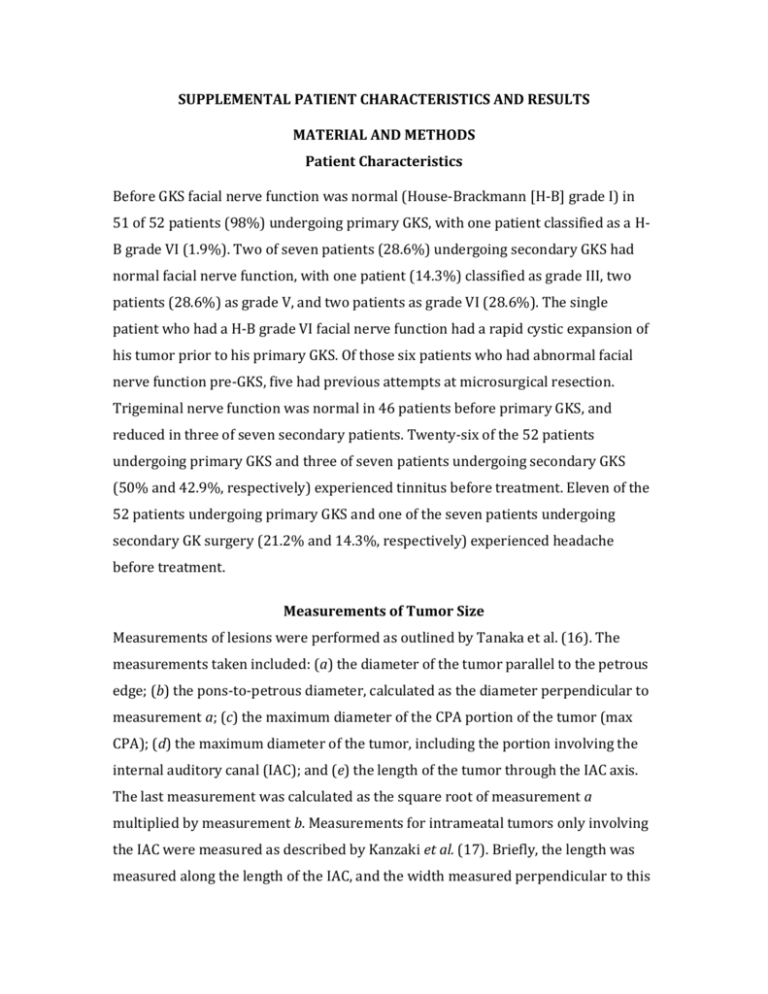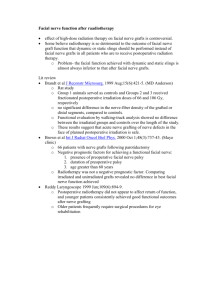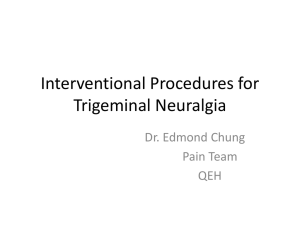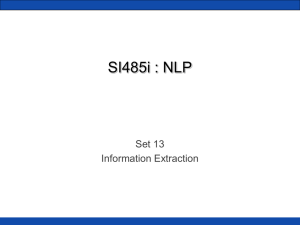SUPPLEMENTAL PATIENT CHARACTERISTICS AND RESULTS
advertisement

SUPPLEMENTAL PATIENT CHARACTERISTICS AND RESULTS MATERIAL AND METHODS Patient Characteristics Before GKS facial nerve function was normal (House-Brackmann [H-B] grade I) in 51 of 52 patients (98%) undergoing primary GKS, with one patient classified as a HB grade VI (1.9%). Two of seven patients (28.6%) undergoing secondary GKS had normal facial nerve function, with one patient (14.3%) classified as grade III, two patients (28.6%) as grade V, and two patients as grade VI (28.6%). The single patient who had a H-B grade VI facial nerve function had a rapid cystic expansion of his tumor prior to his primary GKS. Of those six patients who had abnormal facial nerve function pre-GKS, five had previous attempts at microsurgical resection. Trigeminal nerve function was normal in 46 patients before primary GKS, and reduced in three of seven secondary patients. Twenty-six of the 52 patients undergoing primary GKS and three of seven patients undergoing secondary GKS (50% and 42.9%, respectively) experienced tinnitus before treatment. Eleven of the 52 patients undergoing primary GKS and one of the seven patients undergoing secondary GK surgery (21.2% and 14.3%, respectively) experienced headache before treatment. Measurements of Tumor Size Measurements of lesions were performed as outlined by Tanaka et al. (16). The measurements taken included: (a) the diameter of the tumor parallel to the petrous edge; (b) the pons-to-petrous diameter, calculated as the diameter perpendicular to measurement a; (c) the maximum diameter of the CPA portion of the tumor (max CPA); (d) the maximum diameter of the tumor, including the portion involving the internal auditory canal (IAC); and (e) the length of the tumor through the IAC axis. The last measurement was calculated as the square root of measurement a multiplied by measurement b. Measurements for intrameatal tumors only involving the IAC were measured as described by Kanzaki et al. (17). Briefly, the length was measured along the length of the IAC, and the width measured perpendicular to this plane. It is recognized that differences in the scanning plane and slice selection introduce error in the measurements (18). However, all tumors were measured by two of the authors (DMP, MAM) over a period of several days to maximize the consistency with which the tumors were measured. The percentage change in PTA3, PTA4, PTA-HF, and speech perception pre-GKS compared to 12 months post-GKS were plotted as a function of the percent change in the max CPA dimension. RESULTS Hearing Function and Correlation of Hearing Changes to Radiation Dose, Conformity and Tumor Size While not presented, the percent of each of the four volumes measured receiving 50% of the maximal tumor volume dose was plotted as a function of both the percent change in PTA3 and percent change in speech recognition, as well as the radiation dose normalized to define the Gy/mm3 delivered to each of the four volumes and these data were plotted as a function of the percent change in PTA3 and the percent change in speech recognition. There were no statistically significant differences. Facial Nerve and Trigeminal Nerve Outcomes There was no worsening in H-B grade for any of the 59 patients. One of the primary GKS patients who had H-B grade VI/VI function pretreatment was noted to have H-B grade I/VI function at the six-month follow-up visit. Transient facial spasm was seen in four patients who underwent primary GKS. One described intermittent “lower lip pulling” at the 12-month visit. Two patients described blepharospasm at their 12month visits. The fourth patient described one episode of facial spasm at the 24month visit. In all four of these patients, no recurrence of the transient facial nerve spasm has been noted. Two primary GKS patients had altered taste sensation due to ipsilateral chorda tympani nerve dysfunction for the first 12 months post-treatment that ultimately resolved. One of the primary GKS patients with chorda tympani dysfunction also had ipsilateral geniculate neuralgia symptoms due to nervus intermedius dysfunction lasting six months. Four of the primary GKS patients had a temporary reduction in trigeminal nerve function after treatment, in the distribution of the second division (n=2), the third division (n=1), or all three divisions (n=1). In three patients this resolved by 12 months post-treatment and the fourth patient the dysfunction resolved by 18 months post-treatment. With the exception of this transient trigeminal nerve dysfunction, the trigeminal nerve function was unchanged in all 52 patients undergoing primary GKS. Two of the secondary patients had worsening of their trigeminal nerve dysfunction persisting for 12 months. Headache Eight of the 52 patients undergoing primary GKS and one of the seven patients undergoing secondary GKS (15.4% and 14.3%, respectively) experienced headache after treatment.









